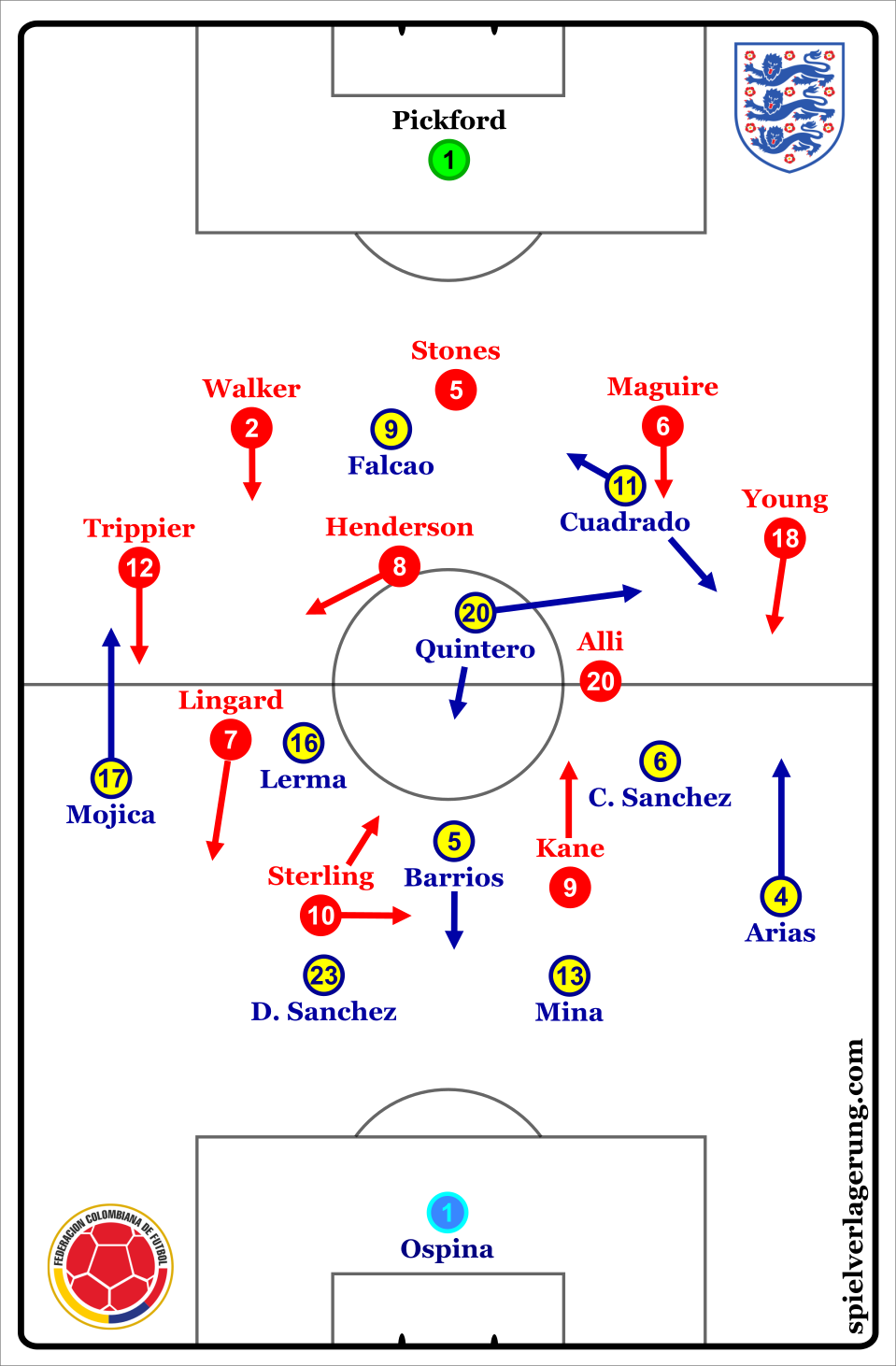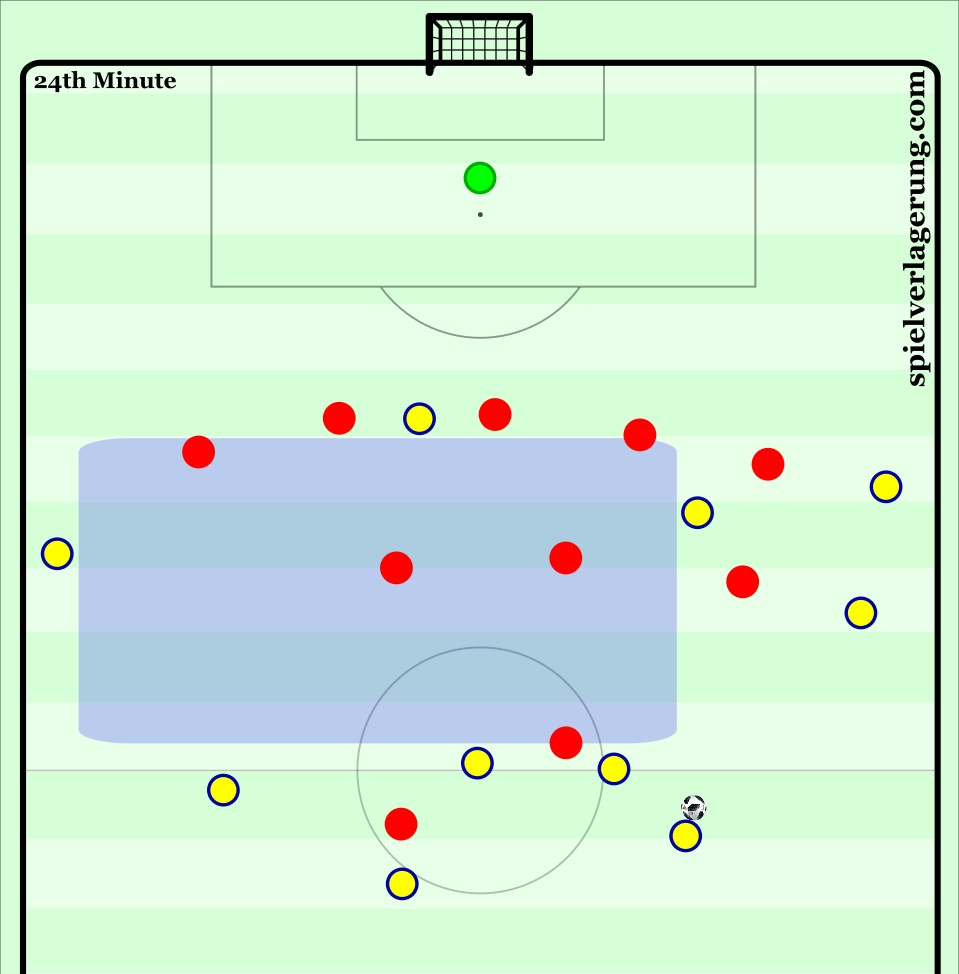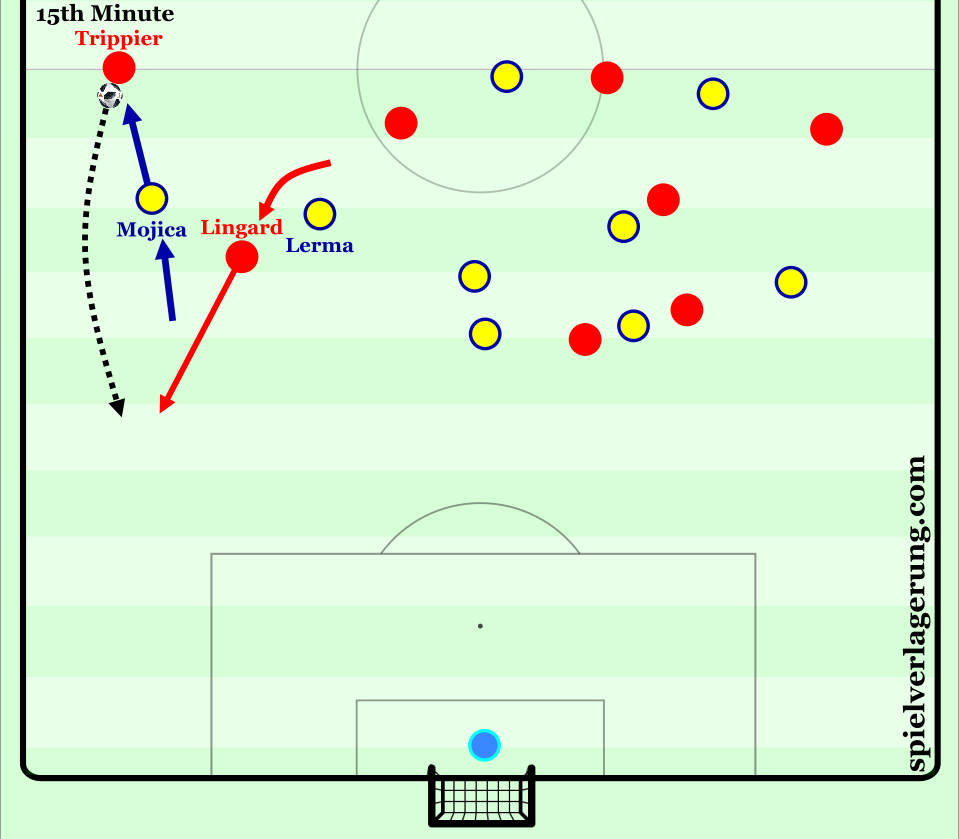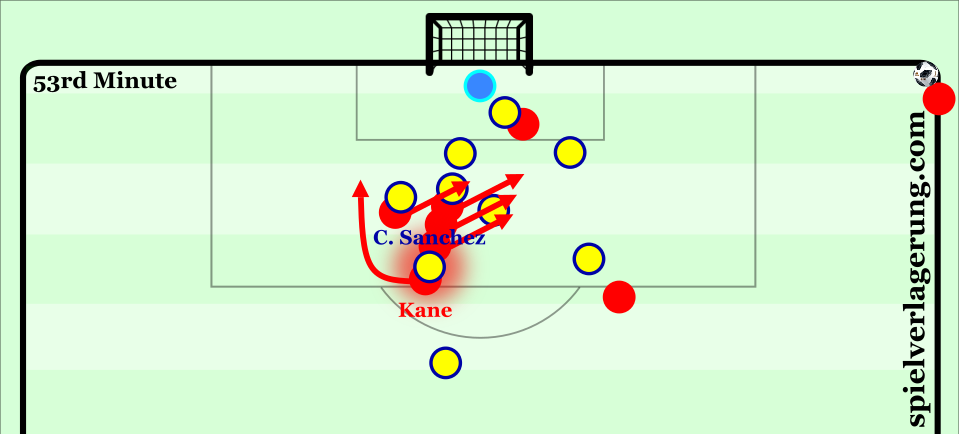Round of 16: Colombia 1-1 England
Colombia took on England in the final last-sixteen match of this World Cup. Colombia were trying to reach a second World Cup quarter-final in a row, whilst England were attempting to win their first knockout match at the World Cup in twelve years.James wasn’t fit enough to even make the bench for Colombia, meaning Lerma came into their starting line-up. For the first time this summer, Colombia played three central-midfielders as opposed to two. England meanwhile reverted to the starting line-up from their first group match against Tunisia, after Southgate rested the majority of England’s strongest side against Belgium in their most recent match. This meant that England’s players were fresher, after Colombia had to fight to qualify for the knockout stages in their final group match against Senegal. It was a hostile environment for England in Moscow, as their fans were vastly outnumbered by the Colombians.
Colombia 1 – 1 England (England win 3 – 4 on penalties… wait, what?)
Colombia’s Problems
 Colombia’s changes in central midfield meant that they had a different build-up structure in comparison to their group stage matches. Barrios operated as the #6 and deepest of their midfield trio, with C. Sanchez on the right and Lerma on the left. Kane and Sterling matched-up to Mina and D. Sanchez, whilst either Alli or Lingard would step out of midfield to cover Barrios in the middle. Alli and Lingard would also mark Colombia’s ball-near outside central-midfielders during their ball circulation across their defensive line. When the ball reached one of Colombia’s wing-backs, Kane or Sterling would use their cover shadows to mark the outside central-midfielders instead, usually forcing backwards passes to the centre-backs or goalkeeper.
Colombia’s changes in central midfield meant that they had a different build-up structure in comparison to their group stage matches. Barrios operated as the #6 and deepest of their midfield trio, with C. Sanchez on the right and Lerma on the left. Kane and Sterling matched-up to Mina and D. Sanchez, whilst either Alli or Lingard would step out of midfield to cover Barrios in the middle. Alli and Lingard would also mark Colombia’s ball-near outside central-midfielders during their ball circulation across their defensive line. When the ball reached one of Colombia’s wing-backs, Kane or Sterling would use their cover shadows to mark the outside central-midfielders instead, usually forcing backwards passes to the centre-backs or goalkeeper.
Colombia’s shape was asymmetric, and didn’t have a coherent structure when attacking inside of England’s half. Mojica, Colombia’s left-back, was their left winger in possession. His isolations against Trippier were Colombia’s only method of progression on the left side. Falcao was slightly left-orientated, but was the only man in Colombia’s final attacking line against England’s three centre-backs, meaning that when he dropped towards the midfield in an attempt to receive passes and hold up the ball, Stones, the middle England centre-back, could step out of defence and follow Falcao, leaving him no time or space on the ball. Colombia had better occupation in the middle of the pitch when Cuadrado moved inside to act as a support striker alongside Falcao, but they still struggled to create anything.
The key-man when Colombia have possession is Quintero, but his positioning was arguably Colombia’s main problem in this match. Prior to kick-off, it seemed that on paper he would be playing on the left-wing, but instead he roamed across the width of pitch from a central #10 position, and was orientated towards his favoured right side, particularly when Cuadrado moved into the middle behind Falcao. This meant that Colombia were largely disconnected to Mojica and their left side, thus nearly all of their attacks were on the right. Colombia’s structure was 4-1-2-3, but the supposed left-winger, Quintero in this instance, was playing in the middle and right half-space instead, leaving the left side completely vacant.
A big factor towards this disorganisation was the absence of James. When Colombia played with both James and Quintero in their final group match, James was positioned on the left wing, with Quintero in the middle. But against England and without James, Quintero continued to play in the middle with no one to replace James on the left. It was unclear whether this was an instruction from Pekerman, or if Quintero’s positional fluidity was executed of his own accord. The manager opted to play an additional central midfielder in Lerma as a replacement for James, but due to Lerma’s more defensive role in comparison to James, the left side of the pitch was left unoccupied in attacking areas, forcing Colombia to the right side to play through Quintero and Cuadrado. Without James, Quintero was the only Colombian player who had the creative capacity to make something happen with the ball, which may be the main reason as to why he sought to play in the middle of the pitch. But due to Colombia’s lop-sided attacking structure and resulting overly-right-sided focus, they created little, and Pickford in England’s goal was largely untroubled.
England: Good, yet bad
Both teams commonly opted to play long balls forward from goal-kicks, but were patient in build-up play when winning the ball in defensive phases of the pitch. During England’s build-up, Quintero man-marked Henderson to try and minimise England’s central progression options. Consequently, Kane, Sterling, and Alli would all intermittently drop to help progress the ball, whilst Henderson dragged Quintero away from the centre of the pitch towards the right half-space. Colombia’s aggressive press tested England. Cuadrado especially was very aggressive in pressurising England’s ball circulation across their back line alongside Falcao, producing a 3-4-1-2 defensive shape with Quintero behind as the #10, whilst Colombia’s full-backs occupied advanced positions to maintain access to England’s wing-backs. Nevertheless, Stones, Maguire, and Walker all performed excellently in possession. All three were extremely composed on the ball. Stones especially executed risky short passes expertly, whilst Walker, and particularly Maguire, had the confidence and ability to progress out of defence with the ball and play intelligent passes. The one major mistake that any of the trio made was when Walker dwelled on the ball towards the end of the match, and an ensuing Colombia counter-attack could have cost England on another day. Trippier and Rose arguably should have been positioned deeper in possession in case a mistake occurred, so that they didn’t have too far to cover in defensive transition, minimising the chances of England’s three centre-backs being left exposed, but Walker usually recovers in these transition situations because of his speed, as he did in this situation. Furthermore, the three centre-backs are not the only England players that are proficient on the ball. Pickford’s composure and excellent distribution were also on display.
In possession, England had a few situational changes in their positional structure. They sometimes moved into a 3-4-2-1 shape, where Alli moved alongside Henderson in central midfield, whilst Lingard moved forwards to be on the right of Kane, with Sterling on the left. From this position, Lingard endeavoured to run into the space beyond Mojica’s on Colombia’s left side, as he was often forced to press Trippier with no other left-sided players on the pitch ahead of him (this wasn’t the case on the right with Cuadrado ahead of Arias). This forced Lerma, Colombia’s outside left central-midfielder, to follow him into the left-back position.
 When Lingard was able to receive the ball in these wide areas, Trippier made underlapping runs in behind the defence, which due to his dynamic advantage he was commonly able to create enough space to get crosses into the box. Whilst this was a fruitful attacking route for England, exploiting Colombia’s positional weakness on their left side, Colombia generally did a good job of neutralising Lingard, who has grown into one of, if not England’s most important midfielder. His positional intelligence in relation to the position of his teammates is his best attribute, which often proves to be important in England’s dynamic attacks. Nevertheless, Lerma’s quasi-man-orientation to Lingard minimised his impact on this match (despite Colombia’s increased defensive stability with Lerma in the line-up, his defensive role when Colombia were attacking developed problems, as discussed earlier).
When Lingard was able to receive the ball in these wide areas, Trippier made underlapping runs in behind the defence, which due to his dynamic advantage he was commonly able to create enough space to get crosses into the box. Whilst this was a fruitful attacking route for England, exploiting Colombia’s positional weakness on their left side, Colombia generally did a good job of neutralising Lingard, who has grown into one of, if not England’s most important midfielder. His positional intelligence in relation to the position of his teammates is his best attribute, which often proves to be important in England’s dynamic attacks. Nevertheless, Lerma’s quasi-man-orientation to Lingard minimised his impact on this match (despite Colombia’s increased defensive stability with Lerma in the line-up, his defensive role when Colombia were attacking developed problems, as discussed earlier).
In addition to their situational 3-4-2-1 shape, Kane would seldom operate as England’s #10 with Sterling and Lingard ahead of him, forming a 3-4-1-2 shape. He would also drop very deep into midfield when England’s lack of creativity meant that minimal goal-scoring chances were being created. Kane was forced to drop when players in deeper positions like Alli dropped to help Henderson in build-up, who was being man-marked out of the game by Quintero.
Despite England’s creative issues from open play, we have seen so far at this World Cup that a lot of their creative emphasis is placed on set-pieces. There were some problems for England from dead-ball situations in this match however, namely the aerial prowess of Mina and D. Sanchez, which proved incredibly difficult to work around. Moreover, there wasn’t as much screening or off -ball actions in an attempt to open up space as there has been previously, which proved successful in Stones first goal against Panama. Instead, the set-piece taker, especially from free-kicks, would routinely aim for Maguire at the back post to head the ball back across the six-yard box, but he was well covered by Mina and D. Sanchez, minimising his ability to prevail in these situations. Additionally, England opted to use corner routines where four players or so would bunch together on the edge of the box, to then make divergent runs as the corner was being taken. Although they didn’t directly score from any such scenarios, they proved effective as they were difficult for Colombia to defend, as the foul on Kane leading to his penalty showed.

The bunching together of three England players directly behind C. Sanchez gave him the impression that he couldn’t run directly backwards when following Kane’s movement as he would be blocked off, meaning that when Kane began his movement towards the far post, C. Sanchez is caught slightly off guard and moves forwards, ending up behind Kane, and is consequently forced to foul him. The clear path for Kane was created by the other four England players within his vicinity running towards the near post, dragging their markers away from Kane with them.
There were other set-piece routines in this match where bunching together on the edge of the box was successfully used by England, such as when spatially-divergent runs from this bunch formation created space for Dier from a corner in extra-time, but he blew the wide-open header.
Adjustments (or lack of) and their consequences
Colombia made a positional adjustment following the half-time interval, by Quintero switching positions with Cuadrado. This change ended up being temporary because of Kane’s goal; Bacca was subbed on for Lerma, moving Cuadrado back to the right wing and Quintero to the middle. Colombia’s players lacked mental composure for the period after England’s goal, committing many senseless fouls, and arguing with the referee, but they grew into the match as a result of their increased attacking focus, and Southgate’s inability to maintain control of it.
In the latter stages of the match when England were protecting their 1-0 lead, the gap between England’s midfield and attack was seldom too large when pressing Colombia’s defensive line. If Colombia’s centre-backs were able to play through Sterling and Kane, which they repeatedly were able to either via the full-backs or central midfielders, then there was a vast space in the middle of the pitch to advance into unpressurised because of England’s 5-3 defensive structure with Sterling and Kane ahead. This was even more apparent when Lingard supported Sterling and Kane’s press, leaving the rest of the team in a 5-2 shape in defensive transition, although Lingard was quick to recover in these situations because of his exceptional work-rate. Due to the disconnectedness of England’s attackers to the rest of the team, and consequently insufficient vertical compactness, England were unable to press Colombia effectively in the final stages of the match, nor could they sustain passing connections when attacking, generating a transition-focused game where Colombia were pushing for the equalising goal. England had lost control.
The lack of changes from Southgate to counter Colombia’s increasing number of attacking players was problematic. For example, no positional adjustment was made in response to the substitution of Bacca for Lerma, which gave Colombia much better occupation and structure on the left side in attacking areas.
This rise in pressure and momentum culminated in Colombia scoring from their first corner, after posing little to no threat on England’s goal for almost the entirety of the match. The tempo of the match was much slower in extra-time, as there was no urgent need to score a goal, in addition to the fact that both sides were fatigued. Instead of Alli intermittently playing alongside Henderson (as was the case earlier in the match), Dier played in a comparatively deeper role to Henderson, who was now positioned in the right half-space ahead of Dier, meaning the substitute had greater responsibility in build-up play. Although Dier was subbed on to try and solidify England’s defence when protecting their 1-0 lead, this was a sub-optimal substitution by Southgate. Firstly, England’s positional structure should have been altered in response to Colombia’s increasingly attacking mindset, but because it wasn’t, the introduction of Dier didn’t add much value to England’s defensive capacity. Colombia of course then equalised, which meant that Dier had to be used in attacking situations during extra-time. Dier doesn’t possess the passing range, or technical and mental ability to handle playing as a lone #6. He misplaced a number of passes, which led to Stones stepping up into defensive midfield when the opportunity presented itself, causing Dier to move into the centre-back position in place of Stones. Dier is much better-suited to playing centre-back than midfield, and looked far more comfortable there after shifting to centre-back in place of Walker, who was substituted off in extra-time. Arguably, Loftus-Cheek should have come on instead of Dier. He is superior in attacking situations, as well as being more mobile and athletic, meaning he could have been a valuable player to have when defending either Mina or D. Sanchez at set-pieces. Luckily for England however, it ultimately didn’t matter.
Conclusion
England again exhibited their balance as a team in this match by controlling the vast majority of it. Their commitment to playing the way Southgate wants them to play, with patience rather than in an urgent, vertical manner, is refreshing to see. Whilst not quite at the lofty heights of their match against Panama, England’s set-piece prowess was also on display, but their attacking deficiencies meant that they couldn’t break through Colombia’s defence from open play. England’s lead was always at risk when it was 1-0, but despite their failure to finish Colombia off, their progression to the quarter-finals via penalties is a deserved one. Colombia will no doubt be disappointed to crash out of the competition the way they did, but their performance was insufficient in terms of deserving to beat England. They lost to a better team.
England’s route to the World Cup final is as good as it could ever be. Their quarter-final opponents shouldn’t be underestimated however. Sweden will be tough and frustrating to play against. Their style of play could be the blueprint that international teams without top-class quality follow in the years beyond this World Cup. In all likelihood, England will dominate possession and impose themselves onto Sweden, who will seek to catch England off guard on the counter-attack and from set-pieces. But considering the capabilities of England’s defence, as well as Sweden’s somewhat-lacklustre attacking quality, England should come out of the match as winners if they perform as well as they can.
Southgate’s young Three Lions are in uncharted territory, yet their confidence is high. Football may or may not be coming home, but the glimmer of optimism prior to the tournament has grown to become the belief of a nation, that for the first time in a generation, it may truly be England’s time.
Keine Kommentare vorhanden Alle anzeigen